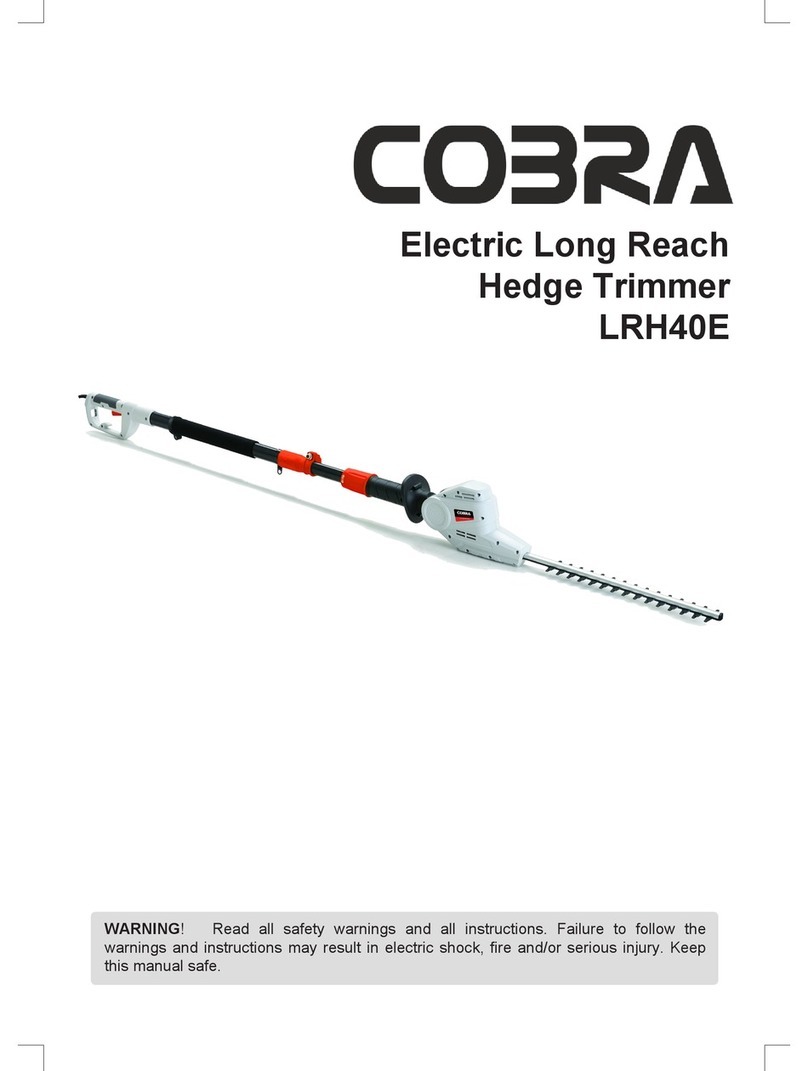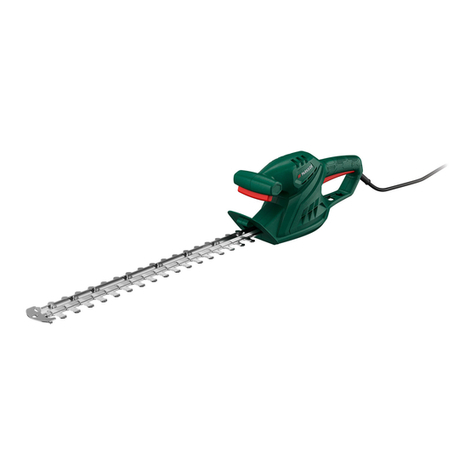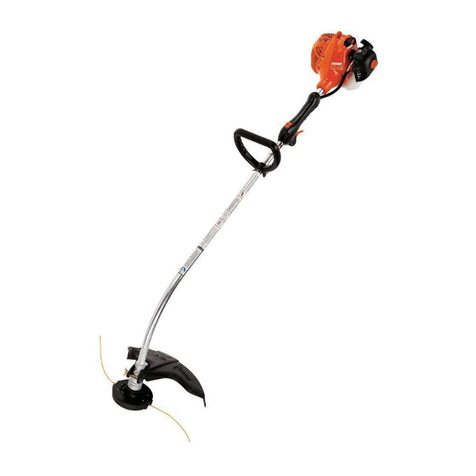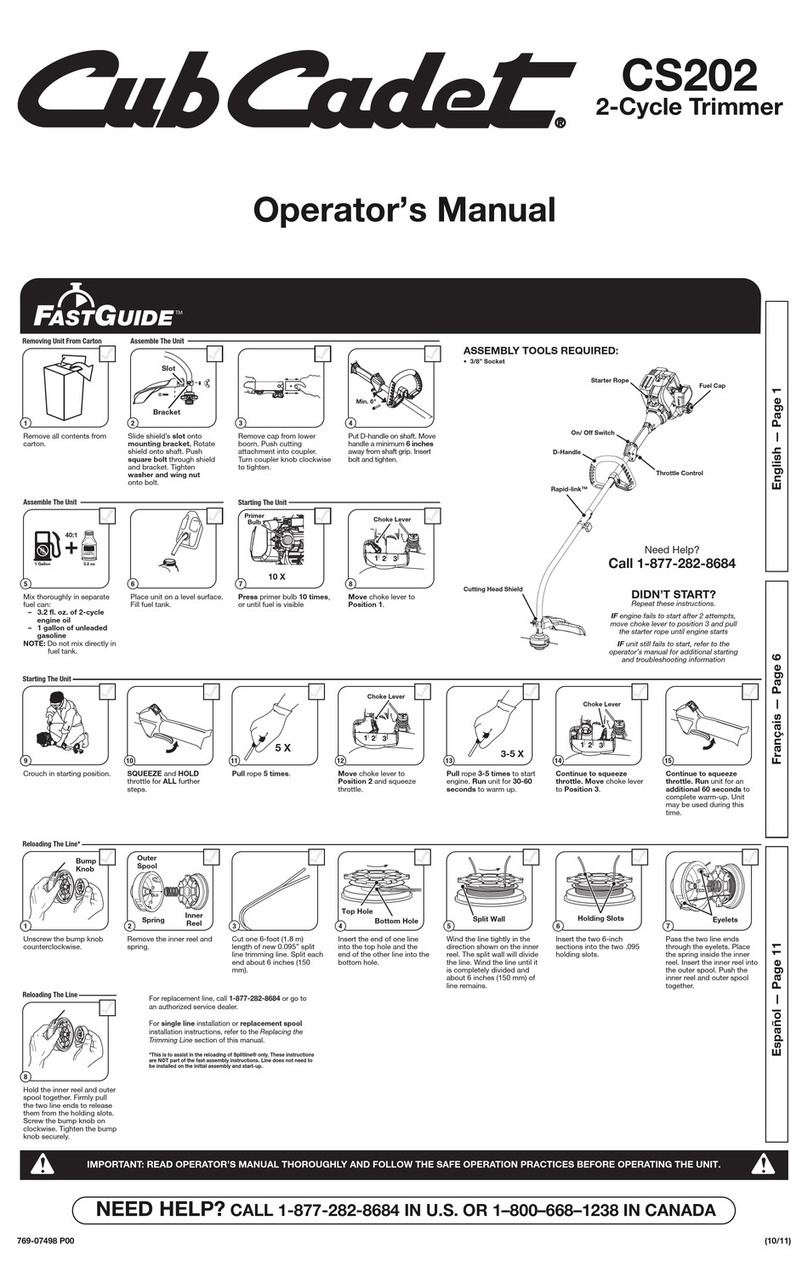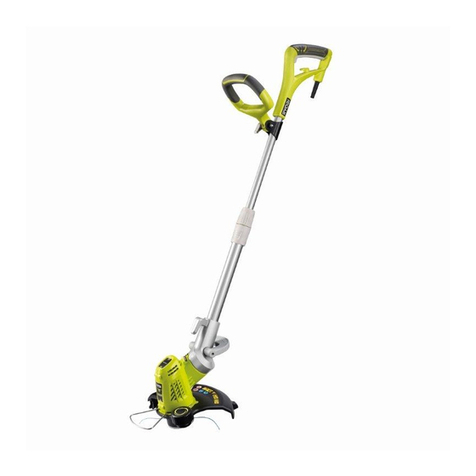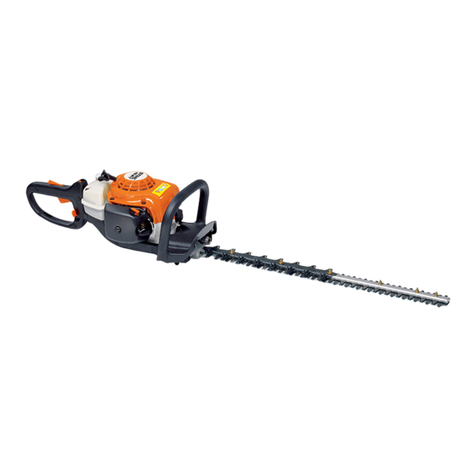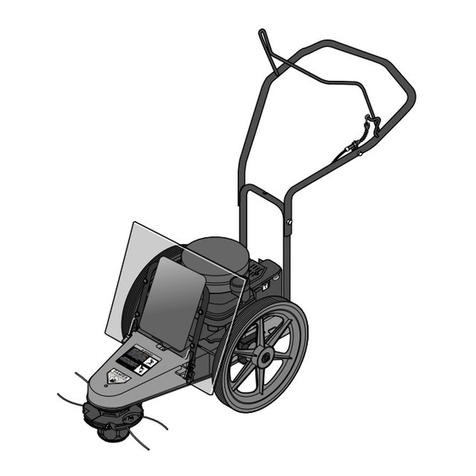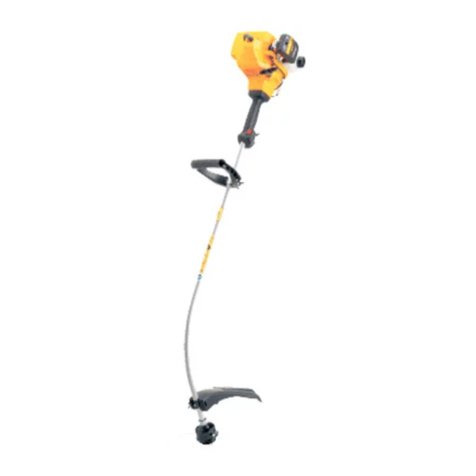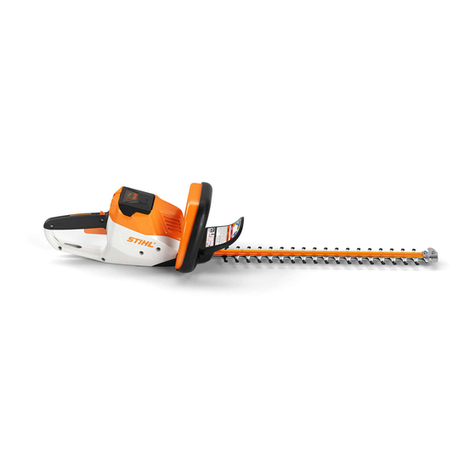Cobra MTX230C Quick reference guide

MODEL: MTX230C
ASSEMBLY & OPERATING INSTRUCTIONS

CONTENTS
ENGINE
PART
BRUSH CUTTER
POLE
PRUNER
HEDGE TRIMMER
Attention Statements
Throughout this manual are special
attention statements.
DANGER!
DANGER!
A statement preceded by the triangular
attention symbol and the word
"WARNING"indicates a potentially
hazardous situation which, if not
avoided, COULD result in death or
serious injury!
CAUTION!
A statement preceded by the word
"CAUTION" contains information
that should be acted upon to avoid
damage to the machine.
IMPORTANT!
NOTE:
A statement preceded by the word
"IMPORTANT" is one that possesses
special significance.
A statement preceded by the word
"ONTE" contains information that is
handy to know and may make your job
easier.
A statement preceded by the triangular
attention symbol and the word
"DANGER"indicates an imminently
hazardous situation which, if not
avoided, will result in death or
serious injury!

DANGER!
Approaching or contacting electrical
lines with the trimmer could cause
death or serious injury. Keep the
trimmer at least 10meters away from
electrical lines or branches that
contact electrical lines.
IMPORTANT!
The information contained in these
instrucitions describes components
available at the time of publication.
While every attempt has been made to
provide the latest information about your
product, there may be some differences
between your attachment and
what is described here. We reserves
the right to make changes to products without
prior notice and without obligation to make
alterations to components
previously manufactured.
The procedures described in this manual
are intended to help you get the most from
your machine as well as to protect you and
others from harm.
these procedures are guidelines for safe
operation under most conditions, and are
not intended to replace any safety rules
and/or laws that may be in force in your
area.
If you have questions regarding your
power tool, or if you do not understand
someting in this manual, your local
dealer will be glad to assist you.
Safety Precautions
THE ARTICULATED HEDGE
TRIMMER IS NOT INSULATED
AGAINST ELECTRICAL SHOCK1
An articulated hedge trimmer has the potential
to do serious damage if misused, abused or
mishandled. To reduce the risk of injury, you
must maintain control at all times, and observe
all safety precautions during operation.
Never permit a person without training or
instruction to operate this machine!

Operating Precautions
Never operate this tool or any
other power equipment if you are
tired, ill, or under the influence of
alcohol, drugs, or any substance
that could affect your ability or
judgement.
Keep bystanders at least 15 meters
(50 feet) away from the operating
trimmer to reduce the risk of being
struck by falling objects or thrown
debris.
Never cut off branches over your
head. The cut-off branches may
hit you and cause serious injury.
read and follow this manual,
make sure anyone using the
trimmer dose likewise. Failure
to do so could result in serious
personal injury or machine
failure. Keep this manual for
future reference.
Always wear a hard hat to reduce
the risk of head injuries during
operation of this machine.In
addition, always wear eye and
hearing protection. We
recommends wearing a face
shield as additional face and eye
protection.
Wear non-slip heavy-duty gloves
to improve your grip on the
trimmer handle. Wear sturdy
footwear with nonship soles to
proivide good footing. Steel-toes
safety boots are recommended.
Were snug-fitting clothes that also
permits freedom of movement.

Operating Precautions
Never permit a person without training
or instruction to operate this machine.
WARNING!
Always make sure the cutter
attachment is properly installed and
firmly tightened before operation.
Never use a cracked or warped cutter
or cutter bar: replace or repair before
use.
Before starting the engine, make sure
the cutter is clear of all objects.
Always stop the engine immedi-ately
and check for damage if you strike a
foreign object or if the machine
becomes tangled. do not operate with
broken or dama-ged equipment.
When cutting a branch that is under
tension, be alert for spring-back so that
you will not be struck by the moving
branch.
Stop the machine immediately if it
suddenly begins to vibrate or shake.
Inspect for broken, missing or
improperly installed parts or
attachments.
Never smoke or light fires near the
hedge trimmer. Keep the trimmer away
from excessive heat. Engine fuel is
very flammable and fire could lead to
serious personal injury or property
damage.-
Never operate this machine or other power
equipment if you are tired, ill, or under the
influence of alcohol, drugs, or any other
substance that could affect your ability of
judgement. Do not operate the tool with the
exhaust removed.
Make sure there is always good ventilation
when operating the articulated hedge
trimmer. Fumes from engine exhaust can
cause serious injury or death. Never run
the engine indoors!
Make sure there are no missing or loose
fasteners, and that the stop switch and
throttle controls are working properly
If a cutter should bind fast in a cut, shut off
the engine immediately. Push the branch
or tree to ease the bind and free the cutter.
Make sure the cutters are correctly
adjusted before operating the articulated
hedge trimmer (see page 17 for cutter
adjustment procedures). Never attempt
cutter adjustment with the engine running!
Make sure of no fuel leaking from Fuel
tank, fuel cap, Fuel pipe and carburetor
and other parts which fuel may leak.
Repair the machine if fuel leaking, make
sure no leaking again.

2
1.
.LOCATION OF PARTS :
Warning Label
ABCD
A: WARNING
B: The Owner’s manual contains important
information on safe operation.
Read it before operating engine.
C: Gasoline is extremely flammable and
explosive.
Stop engine before refueling.
D: Exhaust gas contains carbon monoxide, an
odorless and deadly poison.
Do not run Engine in an enclosed area.
Lift up lever type
Engine Serial Number Label
Engine Serial Number:
The engine serial number is the only means of
identifying your particular engine from others of
the same modeltype.
This engine serial number is needed by your
dealerwhen ordering parts.

7
2.. FUEL AND OIL
RECOMMENDATIONS :
WARNING
Gasoline is extremely flammable and can
be explosive under certain conditions,
creating the potential for serious burns.
Turn the ignition switch to “OFF”.
Do not smoke. Make sure the area is
well-ventilated and free from any source
of flame or sparks;
this includes any appliance with a pilot
light.
Never fill the tank completely to the top.
If the tank is filled completely to the top,
heat may cause the fuel to expand and
overflow through the vents in the tank
cap.
After refueling, make sure the tank cap is
closed securely.
If gasoline is spilled on the fuel tank,
wipe it off immediately.
NOTICE
Running on gasoline only will cause the
engine to seize. Use gasoline-oil mixture.
Kawasaki 2-stroke engine requires a gasoline-
oil mixture.
Gasoline and engine oil mixing ratio:
50:1
(Gasoline 50, 2-stroke engine Oil 1)
Pour the 2-stroke engine oil and the gasoline
into an appropriate container with the ratio
shown above, and shake it thoroughly to avoid
the separation of them. And then, pour it into the
fuel tank.
2 Stroke engine oil
20mL
Gasoline
1000mL
Container mixing fuel (Example)
Fuel Type and Octane Rating
Use clean, fresh unleaded gasoline with ethanol
volume content not more than 10% and an
octane rating equal to or higher than that shown
in the table.
Fuel Type Unleaded Gasoline
Ethanol Content E10 or less
Minimum
Octane Rating
Research Octane Number
(RON) 91
NOTICE
Do not use any fuel that contains more
ethanol or other oxygenates than
specified for E10 fuel* in this engine.
Damage to the engine and fuel system,
or engine starting and/or performance
problems may result from the use of
improper fuel.
* E10 means fuel containing up to 10% ethanol
as specif ed by European directive.
NOTICE
Do not use leaded gasoline, as this will
destroy the catalytic converter. (except
TJ53E)
NOTE
○Do not use gasoline that has been stored
longer than two month.
○To ensure proper starting at low ambient
temperatures, fresh winter grade fuel must
be used.
○If “knocking or pinging” occurs, use a different
brand of gasoline or higher octane rating.
Recommended Engine Oil
High quality 2-stroke engine oil
JASO Service Classif cation - FC class
NOTICE
Do not use 2-stroke oil that contains
Phosphorus (P), Lead (Pb) or Sulfur (S).
These elements will reduce the life and
performance of the catalytic converter.
(except TJ53E)
2.. FUEL AND OIL
RECOMMENDATIONS :
WARNING
Gasoline is extremely flammable and can
be explosive under certain conditions,
creating the potential for serious burns.
Turn the ignition switch to “OFF”.
Do not smoke. Make sure the area is
well-ventilated and free from any source
of flame or sparks;
this includes any appliance with a pilot
light.
Never fill the tank completely to the top.
If the tank is filled completely to the top,
heat may cause the fuel to expand and
overflow through the vents in the tank
cap.
After refueling, make sure the tank cap is
closed securely.
If gasoline is spilled on the fuel tank,
wipe it off immediately.
NOTICE
Running on gasoline only will cause the
engine to seize. Use gasoline-oil mixture.
Cobra 2-stroke engine requires a gasoline-oil
mixture.
Gasoline and engine oil mixing ratio:
40:1
(Petrol 40, 2-stroke engine Oil 1)
Pour the 2-stroke engine oil and the gasoline
into an appropriate container with the ratio
shown above, and shake it thoroughly to avoid
the separation of them. And then, pour it into the
fuel tank.
2 Stroke engine oil
2.5mL
Gasoline
1000mL
Container mixing fuel (Example)
Fuel Type and Octane Rating
Use clean, fresh unleaded gasoline with ethanol
volume content not more than 10% and an
octane rating equal to or higher than that shown
in the table.
Fuel Type Unleaded Gasoline
Ethanol Content E10 or less
Minimum
Octane Rating
Research Octane Number
(RON) 91
NOTICE
Do not use any fuel that contains more
ethanol or other oxygenates than
specified for E10 fuel* in this engine.
Damage to the engine and fuel system,
or engine starting and/or performance
problems may result from the use of
improper fuel.
* E10 means fuel containing up to 10% ethanol
as specif ed by European directive.
NOTE
○Do not use gasoline that has been stored
longer than two month.
○To ensure proper starting at low ambient
temperatures, fresh winter grade fuel must
be used.
○If “knocking or pinging” occurs, use a different
brand of gasoline or higher octane rating.
Recommended Engine Oil
High quality 2-stroke engine oil
JASO Service Classif cation - FC class

3.. ADJUSTMENT OF THROTTLE
CABLE :
Lock nut
Adjusting screw
Idle
screw
Throttle plate
Swivel
Stopper
● When setting the engine to equipments (bush
cutter. Etc.), adjust the throttle cable in the
following procedures.
1.. Remove the air cleaner cap. Loose the lock
nut.
2.. Turn the adjusting screw. Be sure that the
idle screw touches throttle plate at the swivel
and the play of the throttle cable is around
2 mm.
3.. Squeeze the throttle lever. Be sure that
throttle plate touches the stopper.
4. Tighten the lock nut.
4.
.STARTING :
Fuel
● Level the engine before fueling.
● Open the fuel tank cap and f ll the fuel tank
with 50 : 1 gas/oil pre-mixed fuel.
● Pour slowly to avoid “spill back” and allow air
to escape from the fuel tank.
● Close the tank cap securely by turning it
clockwise as far as it will go.
WARNING
Never fill the tank so the fuel level rises
into the filler neck. If the tank is overfilled,
heat may cause the fuel to expand and
overflow through the vents in the tank
cap. After refueling, make sure the fuel
tank cap is closed securely.
If gasoline is spilled on the fuel tank,
wipe it off immediately.
DANGER
Exhaust gases contain carbon monoxide,
a colorless, odorless, poisonous gas.
Do not operate the engine in enclosed
areas. Provide adequate ventilation at
all time.
Throttle lever
Engine switch
● Turn the engine switch on the engine or the
equipment to the “I” (starting) position.
● Move the throttle lever on the equipment to the
fully CLOSED (engine idle speed) position.
Priming pump
Fuel inlet tube
Over flow tube
(transparent)
● Slowly push the priming pump several times
until the fuel comes out of the overf ow tube.
NOTE
○This engine is designed so that overflowed
fuel due to pushing a priming pump is to be
returned to the fuel tank.
○There is no fear of flooding the engine, so
push the priming pump enough times to get
the engine started.
NOTE
○Should the engine fail to start, do not try the
recoil start many times with the lift up lever to
the “STARTING” position or the choke lever
to the “CLOSED” position. This will cause
the fuel to flood into the cylinder and make
starting even more difficult. In this case, set
the lift up lever to the “RUNNING” position or
the choke lever to the “OPEN” position. And
then, repeat the starting.
○After starting, vary the engine speed a few
times, by operating the throttle lever to draw
out the remaining air in the carburetor.

4.
.STARTING continued :
●Turn the lver clockwise to switch to the
“STARTING” position.
NOTE
○If the throttle lever is squeezed or locked
at half position, the engine won’t start. Be
sure the throttle lever is in the fully CLOSED
position.
NOTE
○When the engine is already warm up, no lift
up lever or choke lever required.
Recoil starter grip
●Pull the recoil starter grip slowly to engage
the starter, then give a short, quick pull.
WARNING
Releasing the starting rope suddenly
may allow the rope to whip around and
cause injury and/or damage the recoil
starting mechanism. When starting the
engine, firmly grasp the recoil starter
grip; do not grasp the starter rope itself.
Always control the rope as it rewinds
into the housing.
Throttle lever
Lift up lever
●Squeeze the throttle lever to switch the lift up
lever to the “RUNNING” (engine idle speed)
position, and then release the throttle lever
back to fully “CLOSED” (engine idle speed)

5.
.WARMING UP :
●After starting the engine, run the engine at
the idling speed (throttle lever position is fully
CLOSED) for a few minutes.
NOTICE
Allow sufficient warm-up time to prevent
engine damage and run the engine
smoothly. The engine should be run at idle
speed for a few minutes to allow it to warm
up before applying a load. This will allow
oil to reach engine parts, and allow piston
clearance to reach design specifications.
6.
. ADJUSTING:
Idling Speed
● If the cutting blade move when the engine is
running at the idle speed, turn the idle screw
counterclockwise to decrease the engine idle
speed.
● If the engine does not run the idle speed, it
may be changed too low, turn the idle screw
clockwise to increase the engine idle speed.
The stable idle speed is shown below.
Fuel Adjustment
The carburetor has been adjusted to the
optimum fuel supply at the factory. Don’t reset
the carburetor setting.
NOTE
○If adjustment is needed, it should be
performed by your authorized dealer.
7. STOPPING :
Throttle lever
Engine switch
● Move the throttle lever on the equipment to the
fully CLOSED (engine idle speed) position,
and the engine running at idle speed.
● Turn the engine switch to the “O” (stopping)
position.
NOTICE
Suddenly stopping engine from high-
speed operation can cause engine damage.
Reduce engine speed to idle speed for one
minute before shutting engine off after
high-speed, full-load operation.
Emergency stop
● Turn the engine switch to the “O” (stopping)
position.

Breather
passage
Tank cap
Fuel tank
Breather
assembly
Fuel Tank Cap Service
A breather passage is incorporated in the tank
cap. If the breather passage is clogged, the
fuel will not f ow into the carburetor, causing
problems with starting or running the engine. At
the same time, make sure that the base of the
breather assembly is f tted f rmly into the groove
inside the tank cap as shown.
Air cleaner case
Element
Air cleaner cap
Air cleaner cap screw
Air Cleaner Service
Clean the air cleaner element every 20 hours.
● Remove the air cleaner cap from the air
cleaner case by removing the air cleaner cap
screw.
● Remove the element from the air cleaner
case.
● Wash the element in detergent and water,
and dry it thoroughly.
● Reinstall the element in the air cleaner case
and reinstall the air cleaner, and tighten the
screw.
NOTICE
Improper element cleaning can result in
engine damage.
Do not use compressed air to clean or
dry element. Always clean element with
an approved high flash point solvent
only. Never use gasoline.
Do not operate engine with air filter parts
removed.
Fuel Filter
Fuel Filter Service
Every 20 hours of operation
●Pull the fuel filter out from the fuel tank.
●Clean the fuel filter in a bath of high f ash-
point solvent.
●Dry the fuel filter and reinstall it into the fuel
tank.
NOTE
○If a fuel still does not flow well after the
cleaning, replace the fuel filter with new one.
WARNING
Many solvents are highly flammable
and may cause serious burns. Improper
use of solvents can result in fire or an
explosion. Do not use gasoline or low
flash-point solvents to clean the fuel
filter. Clean only in a well-ventilated area
away from sources of sparks or flame,
including any appliances with a pilot
light.
9. MAINTENANCE :

9. MAINTENANCE continued :
Electrodes
Spark plug gap
Spark Plug Service
Every 50 hours of operation
● Take the spark plug cap with fi ngers, and pull
it up.
● Remove the spark plug by using a suitable
plug wrench.
● Clean the electrodes by scraping or with a
wire brush to remove carbon deposits and
wetness.
● Inspect for cracked porcelain or other wear
and damage. Replace the spark plug with a
new one if necessary.
● Check the spark plug gap and reset it if
necessary. The gap must be between 0.6
and 0.7mm. To change the gap, bend only
side-electrode, using a spark plug tool.
● Install and tighten the spark plug to 14N·m
(1.4kgf·m).
● Fit the spark plug cap on the spark plug
securely.
● Pull up the spark plug cap lightly to make
sure of the installation of the spark plug cap.
Recommended spark plug:
NGK BPMR7A
Spark arrester
Muffler
Spark Arrester Service
Every 50 hours of operation
● Remove the spark arrester from the exhaust
hole of muffl er
● Clean deposits from the spark arrester screen
by brushing it.
● Install the spark arrester.
Carbon Removal of Engine Internal Parts
Every 50 hours of operation
These items must be performed with proper
tools.
See your authorized dealer for service.
10. STORAGE :
Lubricator Plug hole
Engine to be stored over 30 days should be
completely drained of fuel to prevent gum
deposits forming on essential carburetor parts
fuel fi lter and fuel tank.
● Clean the engine.
● Remove all the fuel from the tank and run
the engine at idling to use up the fuel in the
carburetor.
● Remove the spark plug, pour in 0.5 mL of
new 2-stroke engine oil through the plug
hole, pull the recoil starter grip several times,
and reinstall the spark plug.
● Slowly pull the recoil starter grip until
resistance is felt.
● Store the engine in a clean and dry place.
WARNING
Gasoline is a toxic substance. Dispose
of gasoline properly. Contact your
local authorities for approved disposal
methods.

Assembling the Tube Sections
1.Position the power unit and the
attachment on level ground, with the
attachment open end tube facing the
clamp of the power unit tube.
CAUTION!
Keep the open ends of the tubes clean
and free from dirt!
2.Loosen the clamp handwheel screw.
3.Pull out the clamp side pin and insert
the attachment tube into the clamp
housing. Release the spring loaded side
pin and rotate the attachment tube until
it is located by the pin and locks in
position.
3.The attachment is secured by tightening
the handwheel screw. Rotate the
handwheel until the the attachment tube
is locked in position and is secure.
Periodically check that the attachment is
securely fixed in the clamp housing.

WARNING!
General maintenance
Before performing any maintenance,
repair, or cleaning work on the
machine, make sure the engine and
cutting attachment are completely
stopped. Disconnect the spark plug
wire before performing service or
maintenance work.
WARNING!
WARNING!
Muffler
Non-standard parts may not operate
properly with your unit and may cause
damage and lead to personal injury.
Operating the engine without a
muffler or with a muffler that is
damaged or improperly sufficiently to
lead to hearing loss.This machine must never be operated
with a faulty or missing spark arrestor or
muffler is well secured and in good
condition, A worn or damaged muffler is
a fire hazard and may also cause
hearing loss.
SPARK PLUG
Keep the spark plug and wire
connections tight and clean.
Daily maintenance
Prior to each work day, perform the
following:
Remove all dirt and debris from the
engine, check the cooling fins and air
cleaner for clogging, and clean as
necessary. see Figure 33.
Carefully remove any accumulating of
dirt or debris from the muffler and fuel tank first build-up in these areas can lead to engine overheating , fire or premature wear.Check for loose or missing screws or
components. Make sure the cutting
attachment is free of debris and
securely fastened.
Check the entire machine for leaking
fuel or grease.
Make sure nuts, bolts and screws
(expect carburetor adjusting screws)
and tight.
Figure 33

1.PARTS LOCATION
See figure 1
1.Air cleaner
2.Fuel tank
3.Clutch coupler system
4.Ignition switch
5.Throttle trigger
6.Hanger
7.handle A
8.Handle B
9.Handle C
10.Outer pipe
11Debris shield
12.Gearcase
13.Blade
BRUSH CUTTER ATTACHMENT

2. Warning labels on the machine
(1) Read owner's manual before operation this machine
(2) Wear head, eye and ear protection
(3) Warning/attention
(4) Keep all children, bystanders and helpers 15 meters away from the brush cutter.
If warning seals peel off or become soiled and impossible to read, you should contact the
dealer from which you purchased the product to order new seals and offer the new seal in
the required location.
Never remodel your brush cutter.
We won't warrant the machine. If you use the remodeled brush cutter or you don't observe
the proper usage written in the manual.
3. Symbols on the machine
IMPORTANT
WARING

For safe operation and maintenance, symbols are carved in relief on
the machine. According to these indications please be carful not to t
ake mistake
(a)The port to refuel the "mix gasoline"
Position: fuel tank cap
(b)The direction to close the choke
Position:air cleaner cover
(c)The direction to open the choke
Position:air cleaner cover
4. Safety precautions
Before using the machine
A. Read the owner's manual carefully to understand how to operation
this unit properly.
B. This product has been designed for use in cutting grass, and it
should never be used for any other purpose.
C. You should never use the machine when under the influence of
alcohol, when suffering from exhaustion or lack of sleep when suffering
from drowsiness as a result of having taken cold medicine, or at any
other time when a a possibility exists that your judgment might be
impaired or that you might not be able to operate the brush cutter
properly and in a safe manner.
D. Avoid running the engine indoors. The exhaust gases contain
harmful carbon monoxide.
E. Never use your brush cutter under circumstance like those
described below.
1. When the ground is slippery or when other conditions exist which
might make it impossible to maintain a steady posture while using the
brush cutter.
2. At night at times of heavy fog. Or at any other time times when your
field or vision might be limited and it would be difficult to gain a clear
view of area.
3. During rain storms, during lightning storms at times of strong or gale-
force winds,or at any other times when weather condition might make it
unsafe to use this machine.
F. When using this machine fo the first time, before beginning actual
work learn to handle brush cutter from skilled workers.
G. Lack of sleep tiredness, or physical exhaustion result in lower attention spans.and
this in fact can lead to accident and injury.limit the amount of time which the bush cutter
is to be used continuously to somewhere around 30-40 minutes per session, and take
10-20 minutes of rest between work session. Also try to keep the total amount of work
performed in a single day under 2 hours or less.
H. Be sure to keep this manual handy so you might refer to it later or whenever the
questions arise.

I. Always be sure to include this manual when selling lending, or otherwise transferring
the ownership of this product.
J. Never allow children or anyone unable to fully understand the directions given in
this manual to use this brush cutter.
WORKING GEAR AND CLOTHING
A. When using you brush cutter, you should wear proper
clothing and protective equipment as follows.
1. Helmet
2. Protection goggles or face protector
3. Thick work gloves
4. Non-slip-sole working boots
5. Ear protector
B. And you should carry with things as follows
1. Attached tools and files
2. Properly reserved fuel
3. Spare blade
4. Things to notify your working area(tape, warning signs)
5. Whistle(for collaboration oe emergency)
6. Hatchet or saw(for removal of obstacles)
A. Before beginning work, look around carefully to get a feel for the shape of land, or
grass to be trimmed and whether or not there are any obstacle which might get in the
way while working, and remove any
C. Never use your brush cutter when you wearing pants with loose cuffs, when wearing
sandals, or even barefoot.
WARNING CONSIDERING HANDLING OF FUEL
A. The engine of this product is designed to run on a mixed
fuel,which contains highly flammable gasoline. You should never
store cams of fuel or refill the fuel tank in any place where there is a
boiler, stove, wood fire, electrical sparks, welding sparks, or any
other source of heat or fire which might ignite the fuel.
B. Smoking while operating the brush cutter or refilling its fuel tank is extremely
dangerous. Always be sure to keep lit cigarette away from brush cutter at all times.
C. When refilling the tank always turn off the engine first and take a carefully look
around to make sure that there are no sparks or open flames anywhere near by before
refueling.
D. If any fuel spillage occurs during refueling, use a dry rug to wipe up spills before
turning the engine back on again.
E. After refueling screw the fuel cap back tightly onto the fuel tank and then carry the
brush cutter to a spot 3meter more away from where it refueling before turn on the
THINGS TO CHECK BEFORE USING YOUR BRUSH CUTTER

Obstacles, which can be cleared away.
B. The area within a perimeter of 15m of the person using the brush cutter should be
considered a hazardous area into which no one should enter while the brush cutter is in
use, and when necessary yellow waning rope, warning signs should be placed around
work area. When work is to be performed simultaneously by
two or more persons, always check the presence and
locations of others so as to maintain a distance each person
sufficient to ensure safety.
C. Make sure that there are no loose screws or bolt, fuel
leaks, ruptures, dents, or any other problems, which might
interfere with safety operation.Be especially careful to check
that there is nothing wrong with the blades or with the joints
by which the blades are attached to the brush cutter.
D. Never use blades that are bent, warped cracked, broken or
damaged in any way.
E. Keep the blade always sharp.
F. Filling the cutting edge, keep the end corner sharp and
round the root of the edge.
G. Check the bolt to fasten the blade and be sure the blade
turn smoothly without abnormal noise.
NOTES ON STARTING THE ENGINE
1. Take a careful look around to make sure that obstacles exist within a perimeter of
15m or less around brush cutter.
2. Place the brush cutter onto the ground in a flat clear area and hold it firmly in place
so as to ensure that neither the blades nor the throttle came
into contact with any obstacles when the engine start up.
3. Place the throttle into the idling position when starting
the engine.
4. After starting the engine. Of the blades continue to rotate
even after throttle has been move fully back fully turn off
the engine and check the throttle wire and other parts.
KICKBACK SAFETY PRECAUTIONS
A dangerous reaction may occur when the spinning blade contact a solid object in the
critical area. It is called kick back, as a result, the operator can lose control of the unit
which can cause serious or total injury.
Avoid kickback; observe the safety precautions below strictly.
1.Before beginning work, clear your working area and remove grass around the
obstacles.
2.When using your brush cutter, do not grip other parts except the handles.

1. Perform the maintenance and checking operations described in this manual at regular
intervals. If any parts must be replaced or any maintenance or repair work not described
in this manual must be performed. Please contact a representative from the nearest
store authorized servicing dealer for assistance.
2. Under no circumstances should you ever take apart the brush cutter or after it in any
way. Doing so might result in the brush cutter becoming damaged during operation or the
brush cutter becoming unable to operate properly
3. When using your brush cutter, never take you eyes off. If you need to, place you
throttle into idling position.
4. When using your brush cutter. Do not let the unit get closer to your feet nor raise the
unit above your waist.
1. Make sure the appropriate blade is in placed.
2. When transportation by car, fix the unit firmly using a rope. Do not transport by bicycle
or motorcycle because it is dangerous.
3. Never transport brush cutter in a rough road over long distance without first removing
all fuel from fuel tank, as doing s might cause fuel to leak from tank.
NOTES ON TRANSPORTATION
OPERATION SAFETY PRECAUTIONS
1. Grip the handle on the brush cutter firmly with both hands. If you suspend the work,
place the throttle into the idling position.
2. Always be sure to maintain a steady,even posture while working.
3. Maintain the speed of the engine at the level required to perform
cutting work, and never raise speed of the engine above the level
necessary.
4. If the grass get caught in the blade during operation, or if you nee to
check the unit or refuel the tank, always be sure to turn off the engine.
5. If the blade touches a hard object like a stone, stop the engine
immediately and check if something wrong with the blade, if so, replace
the blade by new one.
6. If someone calls out while working, always be sure to turn off the
engine before turning around.
7. Never touch the spark plug or plug cord while the engine is in
operation.doing so may result in being subjected to an electrical shock.
8. Never touch the muffler, spark plug or other metallic parts of the
engine while the engine is in operation or immediately after
shutting down the engine. Doing so may result i serious burns.
9. When you finis cutting in one location and wish to continue work
in another spot, turn off the engine and turn the unit as the blade
faces away from your body.
MAINTENANCE SAFETY PRECAUTION
Other Cobra Trimmer manuals

Cobra
Cobra HT5024V User manual
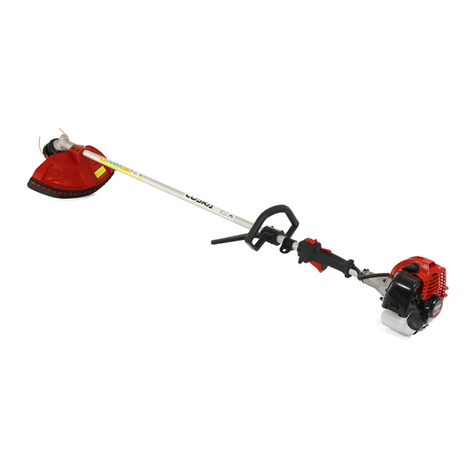
Cobra
Cobra GT260C User manual
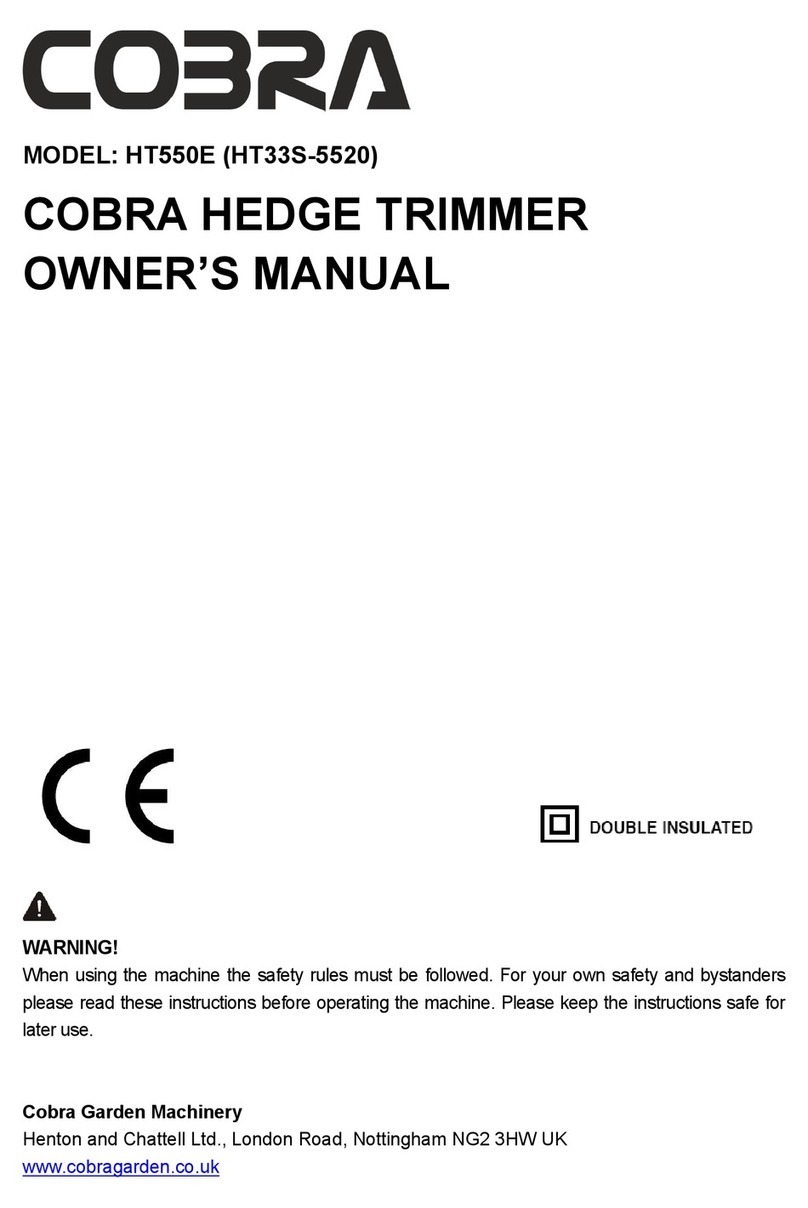
Cobra
Cobra HT550E User manual
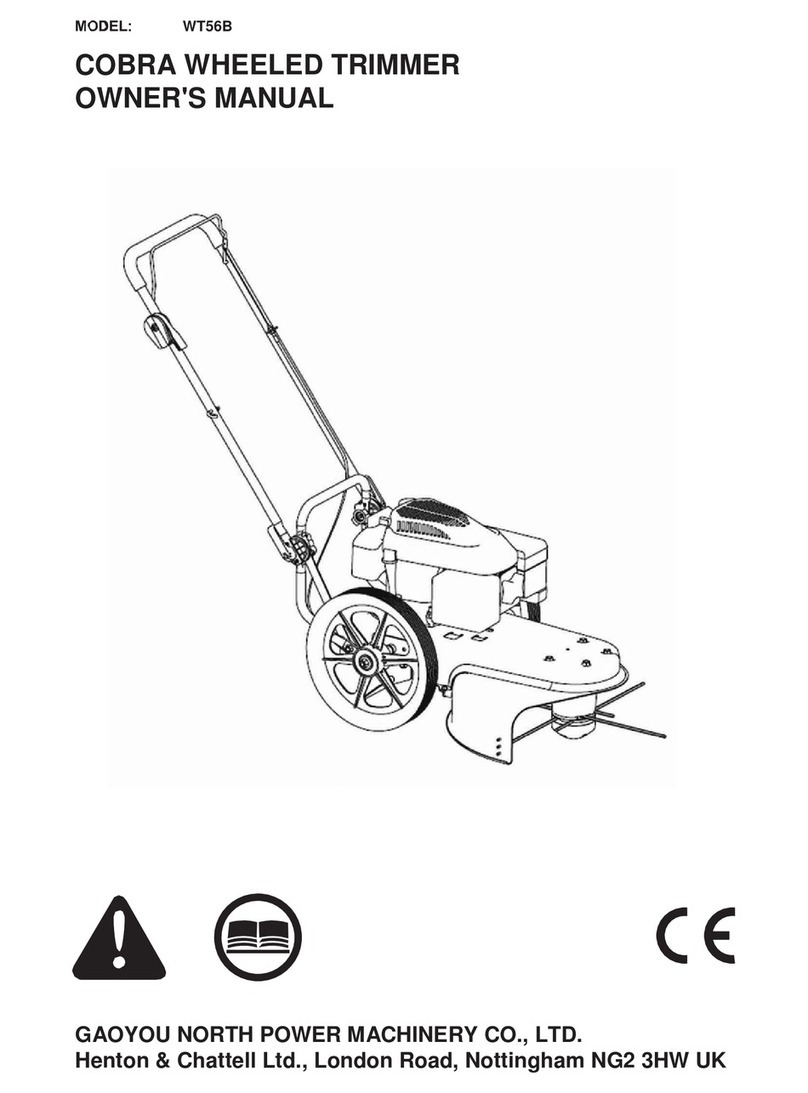
Cobra
Cobra WT56B User manual
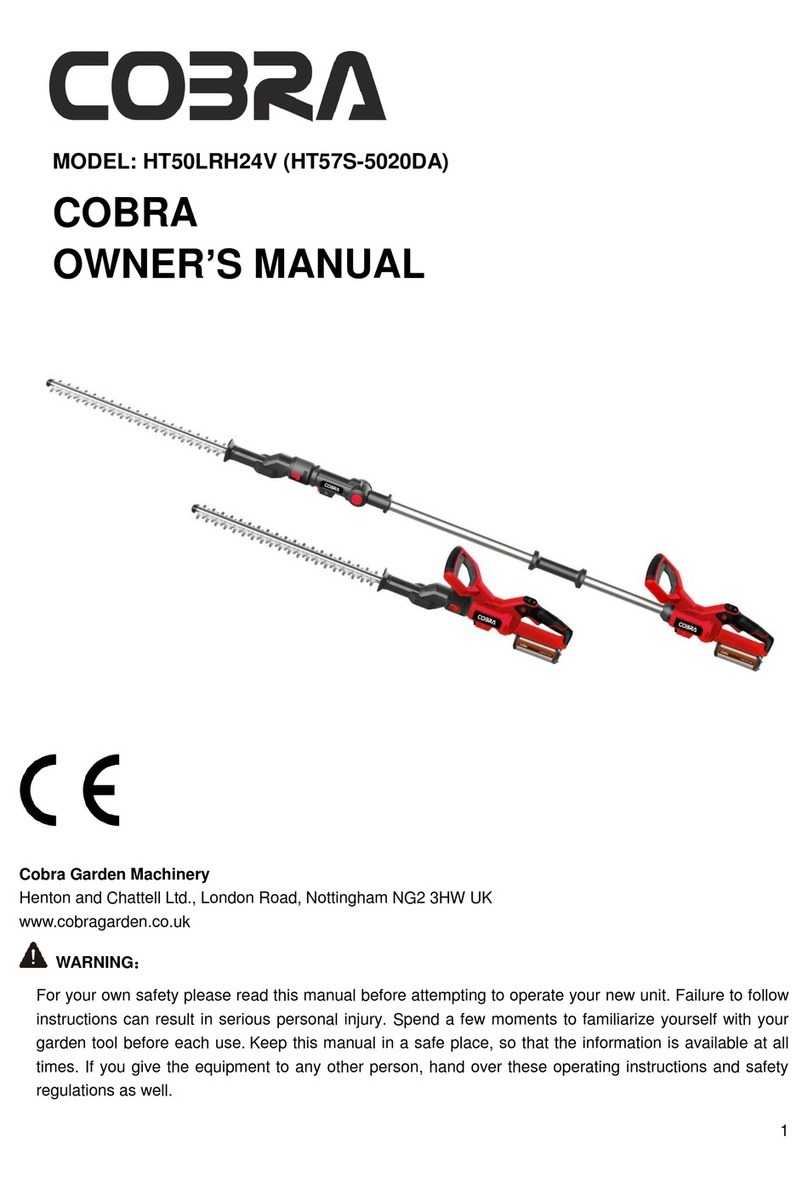
Cobra
Cobra HT50LRH24V User manual

Cobra
Cobra MT250C User manual
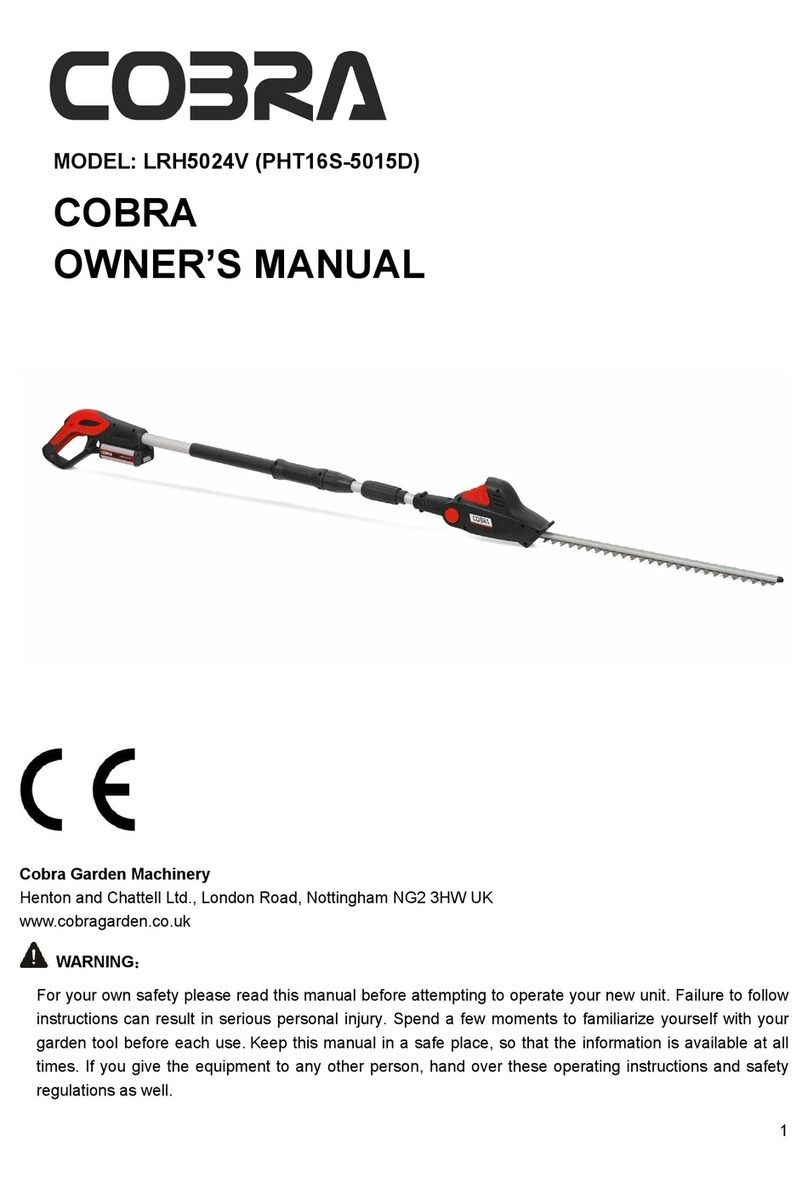
Cobra
Cobra LRH5024V User manual
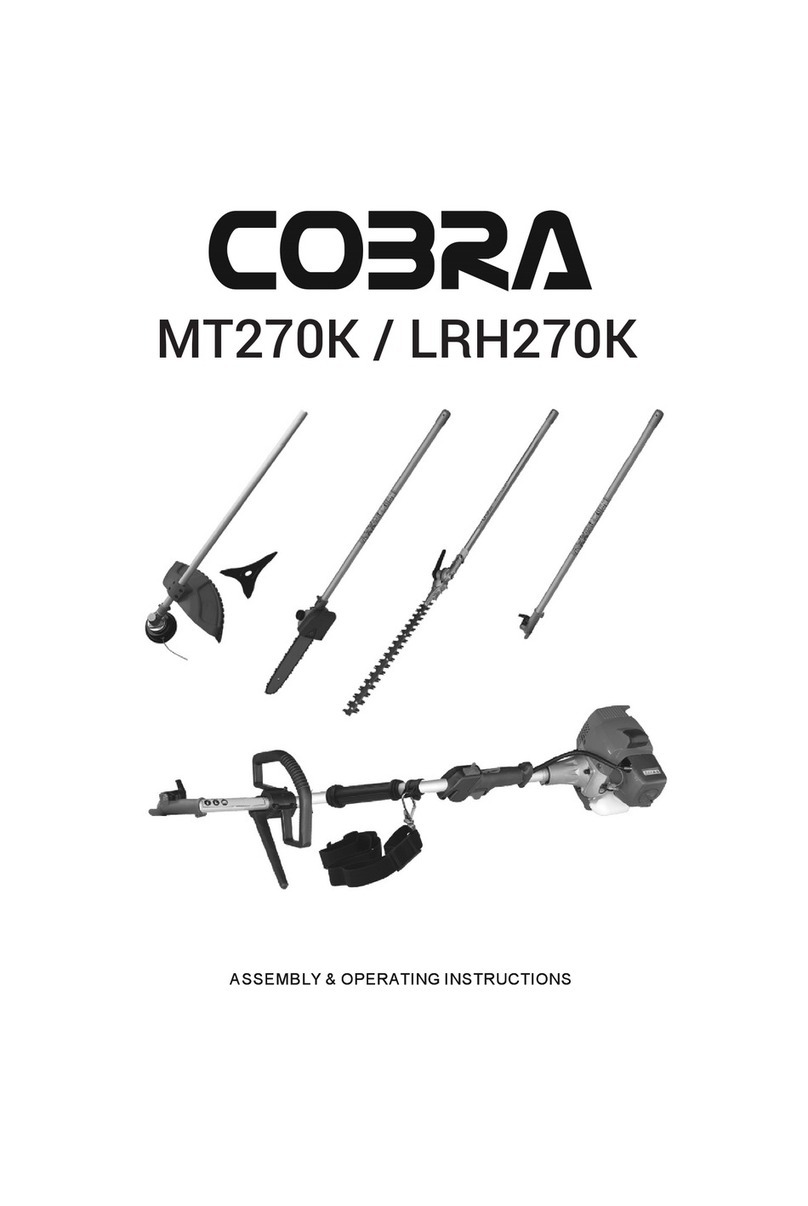
Cobra
Cobra MT270K Quick reference guide
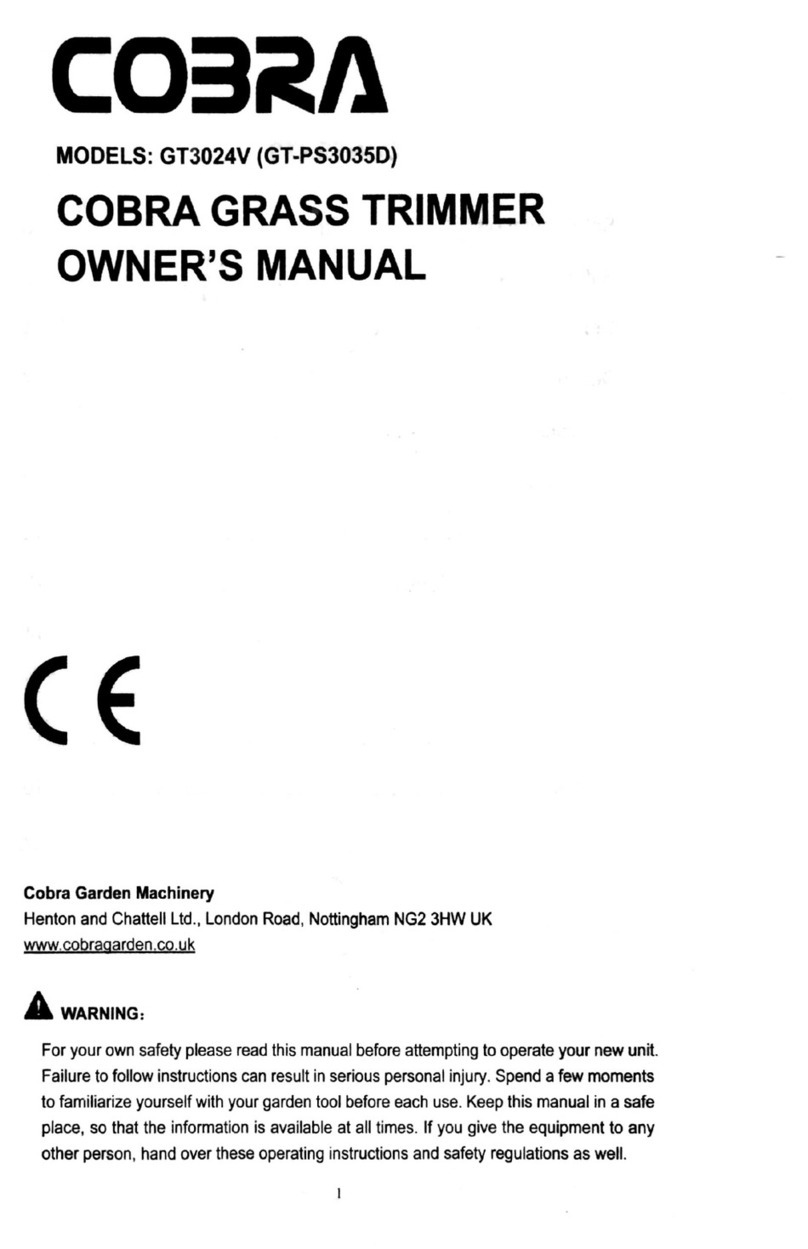
Cobra
Cobra GT3024V User manual

Cobra
Cobra H55E User manual
Popular Trimmer manuals by other brands
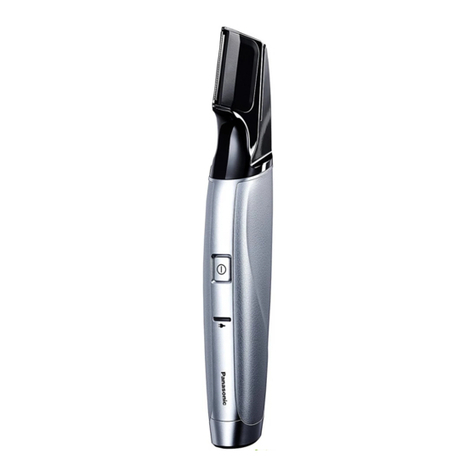
Panasonic
Panasonic i-Shaper ER-GD60 operating instructions
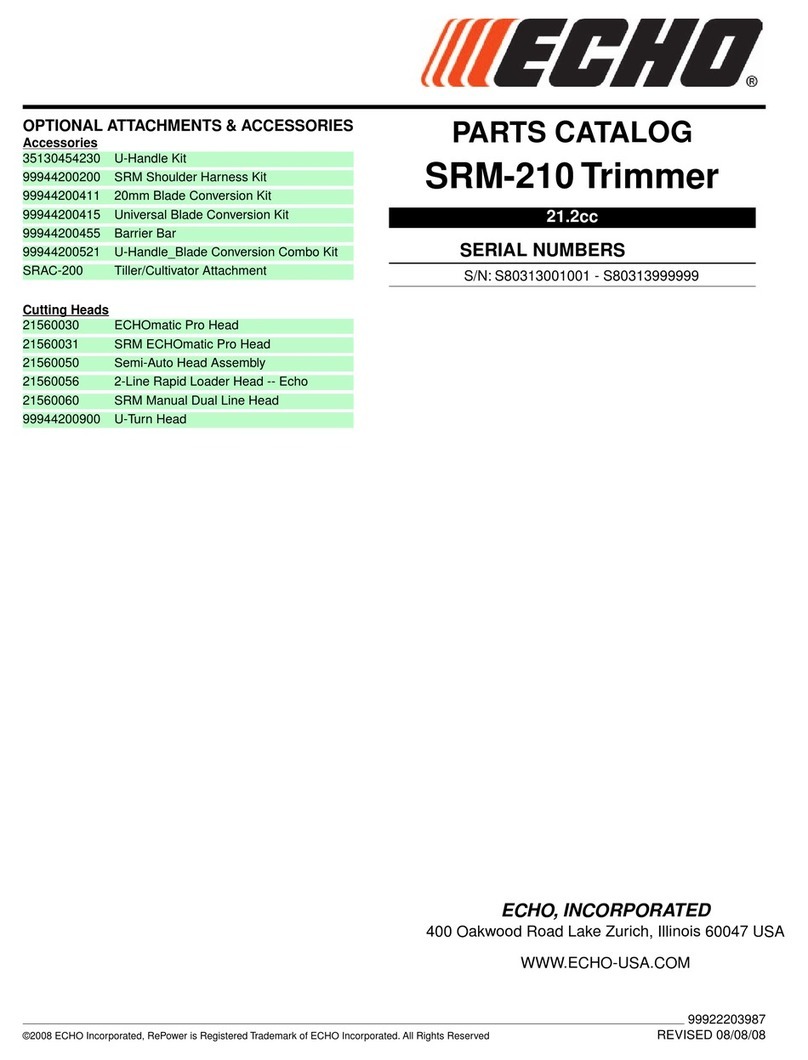
Echo
Echo SRM-210 - PARTS CATALOG SERIAL NUMBERS... parts catalog

Shindaiwa
Shindaiwa T235 Operator's manual
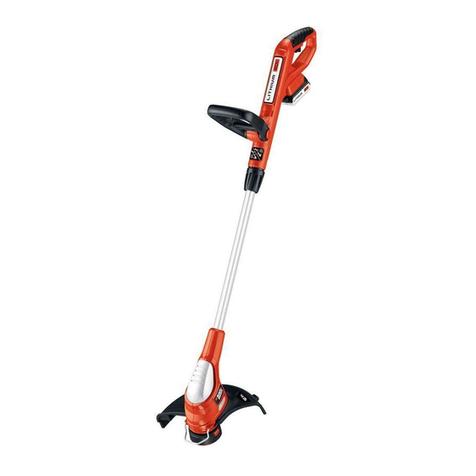
Black & Decker
Black & Decker LST220 instruction manual
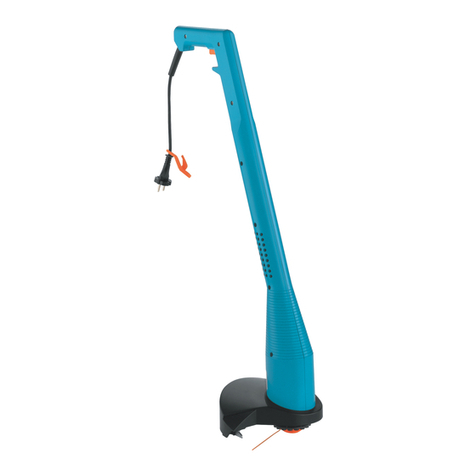
Gardena
Gardena 230 M operating instructions
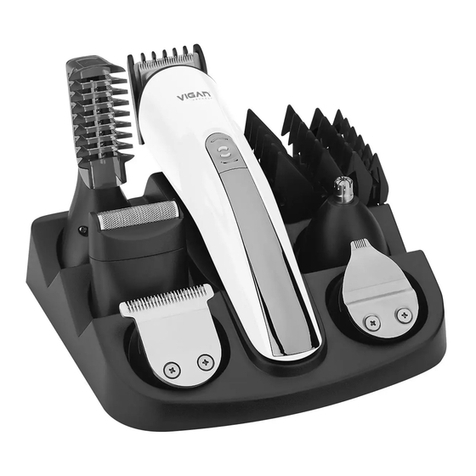
Vigan Mammoth
Vigan Mammoth ZB6V1 user manual
